How to flatten boards without a jointer
While you are waiting to buy an 8- or 12-in.-wide jointer that can keep up with your planer, Asa Christiana gives you a few great ways to get flat, straight boards without owning a wide jointer.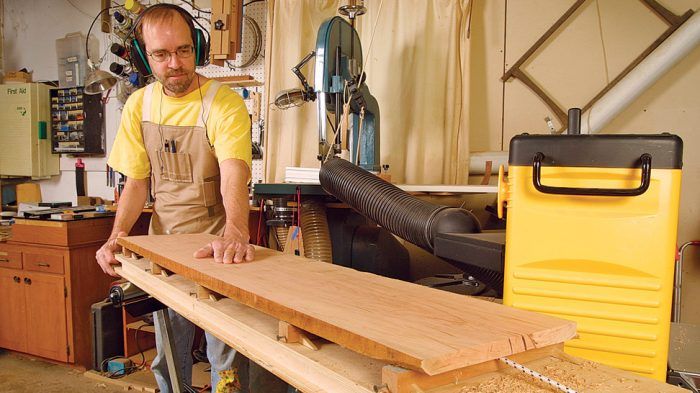
One of the first milling tools most people buy is a thickness planer. That’s because a 12- or 13-in.-wide lunchbox-style planer is relatively affordable. Soon afterward, you discover your beautiful planer’s Achilles heel: Send in a curved board, and it emerges just as curved—smooth, yes, with uniform thickness, but what good is that if the board is still warped?
You’ve encountered one of woodworking’s inconvenient truths: You need a way to flatten one side of a board before sending it through the planer. The best solution is a jointer: Joint one surface of any board flat and straight, send that board through the planer—flat face down on the bed—and a beautiful workpiece rolls out the other side, with two, flat, straight, smooth, parallel faces.
Here’s the rub: The jointer is a heavier, pricier tool than a basic planer, and any model wider than 6 in. starts getting pretty expensive, even if you buy it used (not a bad idea). That means you don’t just need a jointer; you need one as wide as the boards you’ll commonly use.
Don’t panic just yet. While you are waiting to buy an 8- or 12-in.-wide jointer that can keep up with your planer, or maybe even a 12-in. jointer/planer combo machine with a segmented carbide head (insert angelic chorus), here are a few great ways to get flat, straight boards without owning a wide jointer. I’ll start with the simplest option, showing you just how easy it is to get out of jointer jeopardy.
Buy straight boards to begin with
The simplest method is to be choosy at the lumberyard. If you can sort through the stacks, you’ll likely find nice-looking boards that are almost perfectly straight to start with.

A few words of warning. This works best if the lumber was stored indoors, closer to the conditions of your shop. That’s because wood moves and warps when the relative humidity changes. So this is a good method for finding straight boards to put through your planer, but not the best.
All three of the following methods let you take full control of your lumber and flatten any board. All involve some kind of sled, which provides a flat reference surface for the planer, with the wonky board held on top and wedged so it doesn’t rock as the planer rolls. Better yet, these videos and articles are all free on FineWoodworking.com. The only difference between the sleds is how long it takes to make each one vs. how long it takes to set it up.
Simple sled is quick to build
In this quick video, Dillon Ryan demonstrates the simplest path to flattening wide boards in your planer, using the most basic of sleds. This one is nothing more than a piece of plywood with a stop on one end, to keep the board from sliding off the sled, plus small edges hot-glued under the stock on the top side. You can make it from scrap in about 10 minutes, and if you make it long enough, it will work on all sorts of boards.
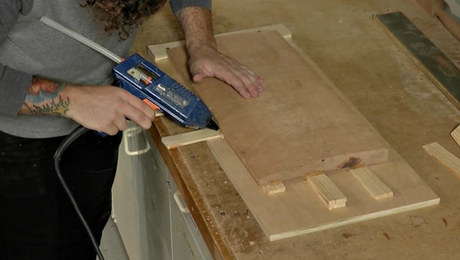
A few construction notes. If you do make the sled longer, I would be sure to make it from 3/4-in. plywood for rigidity. And be sure to wax the bottom for easy sliding, as noted in the video. You might also make it from melamine particleboard so it will slide easily and any stray hot glue will be easier to peel off.
Use a straightedge clamp for a sled that sets up fast
If you lack a wide jointer, you’re going to need your planer sled pretty often, so it’s nice to have one that is quick to set up and always ready to go. That’s why this jointing sled is my personal favorite. It offers an excellent balance of short construction time and fast setup.
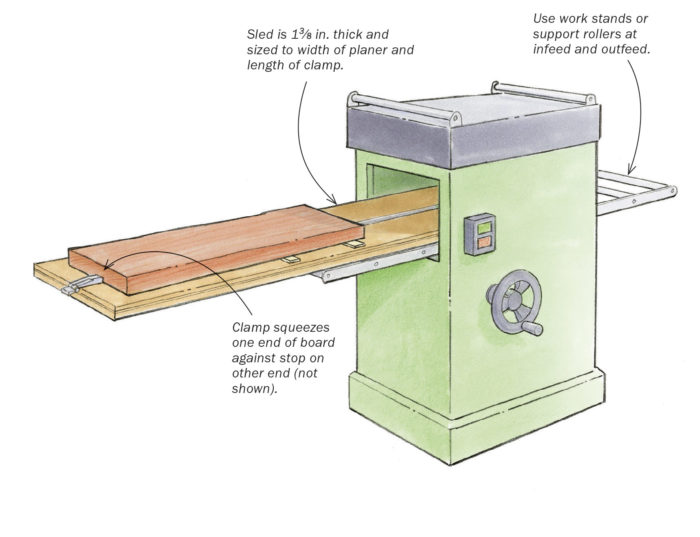
This sled is drawn from the Workshop Tips department of FWW, and is built around one of those long clamp-on straightedges you can use to guide a circular saw or router. In this case, it’s inset into the sled, so it can grab the front and back edge of any board. After that, you just stick a few wedges under the board to level and stabilize it, and into the planer it goes. Like the next sled below, you could just build this one and use it indefinitely, never needing a jointer at all.
That said, you’ll still want a wide jointer someday, if you have the space and cash. It’s lovely to have that amazing machine always at the ready.
Like building cool jigs? This planer sled is the king
With built-in leveling bars that will stabilize any board, this amazing jig sets up the fastest. It takes more time to build than the previous two, but it’s darn impressive. It’s also heavier than the other sleds, so I would add a support stand at the back end of the planer to help me handle it.
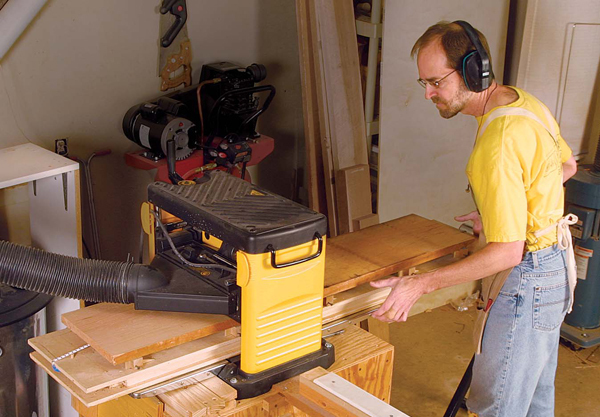

You can get the full article just by entering your email address, and/or watch the free video that goes with it. It’s pretty cool!
Bonus tip: Flatten boards just a little wider than your jointer
This tip is an exception to the others, but it’s the easiest approach of all if you have a jointer but it’s just an inch or two narrower than your boards. It’s actually a combination of a special jointer technique and the simplest of planer sleds: a plain piece of plywood.

While the inestimable Mike Pekovich didn’t invent this technique, he demonstrates it beautifully in his video series on making a hayrake-style dining table. You’ll need a membership to watch this one, but a FWW.com membership is the best tool you can buy!
Fine Woodworking Recommended Products
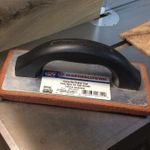
Grout float

Hedgehog featherboards

Incra Miter 1000HD














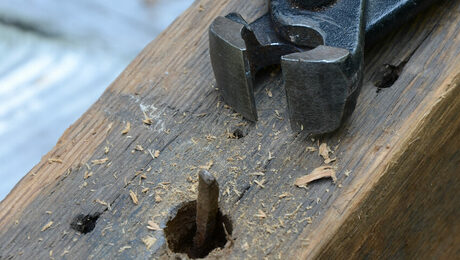








Log in or create an account to post a comment.
Sign up Log in